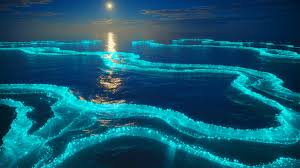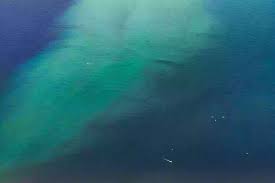Even NASA could not believe it: A “Glowing Ocean Creature” glowing in the ocean near Australia, visible even from Space!
🌊 At first glance it seems like a sci-fi movie, but this is completely real.
NASA’s satellites saw a sight near the southern coast of Australia that astonished scientists around the world. A large part of the ocean, between the Tasman Sea and the Great Australian Bight, was glowing turquoise i.e. blue-green. For the first time, NASA’s PACE spacecraft captured this glowing ocean phenomenon. The reason behind this glowing effect is a massive bioluminescent phytoplankton bloom – a natural luminous organism that can be seen even from space.

🌌 This natural glow seen from space
NASA’s new PACE (Plankton, Aerosol, Cloud, Ocean Ecosystem) satellite detected this glowing zone using the Ocean Color Instrument (OCI). This glow was seen in the waters between mainland Australia and Tasmania. This area has deep ocean channels and fast-flowing currents that bring nutrients up – a perfect condition for phytoplankton to bloom.
Earlier also, Suomi NPP, Terra and Aqua satellites observed glowing blooms like this in late 2023 and early 2024. But this time the glow was so intense that even NASA scientists were astonished.
🔬 What is the scientific secret of this glow?
This turquoise glow is not due to any magical thing, but is caused by the pigment chlorophyll-a. Chlorophyll-a is a natural green pigment found in phytoplankton – these microscopic plant-like organisms are found in the photic zone (where sunlight reaches) of the ocean.
Phytoplankton need sunlight and nutrients (like nitrogen and phosphorus) to grow, which are obtained from the breakdown of dead organisms in the ocean. According to oceanographer Jochen Kaempf of Flinders University, the green filaments visible from space are evidence of a phytoplankton bloom that extends up to a shelf break 500 feet deep.
The blue regions surrounding the sparkling turquoise area could be caused by sediment disturbance or another type of phytoplankton species. A complex and beautiful ecosystem develops amidst all of this.
🐋 A Heaven for Marine Life
These glowing blooms are not just a visual treat, but the foundation of life. About 80 blue whales are attracted each year around the Bonney Coast, where krill and other smaller marine creatures that feed on phytoplankton are found.
It’s not just for whales — these blooms are essential for sardines, anchovies, tuna, crabs and many other fish species. This has made the region a major hotspot for marine biodiversity.
NASA scientists also say these phytoplankton play a major role in oxygen production and global climate regulation. Through this process, carbon dioxide is absorbed from the atmosphere and oxygen is released – meaning these tiny organisms help our planet breathe.

🚀 What’s next? Future of Ocean Exploration
The discovery of this glowing bloom has once again proved that there are many secrets hidden beneath the ocean that we are yet to discover. With the satellite technology of NASA and other space agencies, we can now regularly monitor such natural events.
As remote sensing and satellite imaging become more advanced, we will gain a deeper understanding of climate change, ocean health, and marine biodiversity. Perhaps more such glowing creatures, blooms, or marine phenomena are still waiting for our eyes under the sea.
📌 Conclusion
This glowing phytoplankton bloom seen in the sea near Australia is not just a beautiful sight, but a scientific miracle. This shows that there are still many such miracles in nature that can astonish human eyes – and with the help of science it is now possible to understand them.
Are you ready for such new natural wonders, which are visible from space but are hidden in the heart of the ocean?
